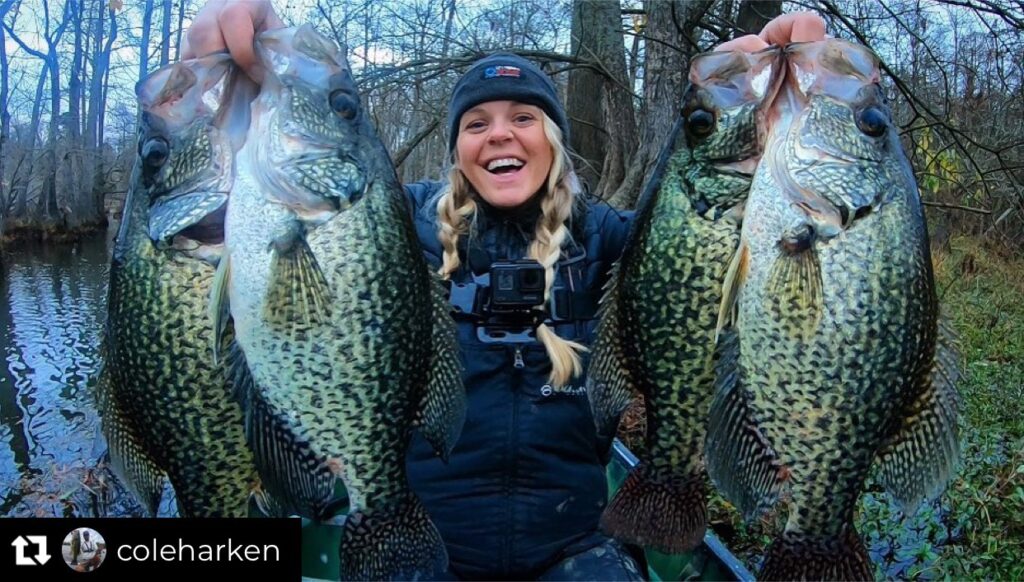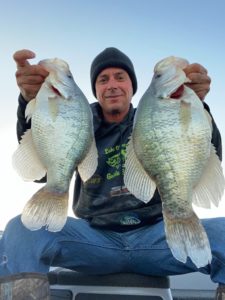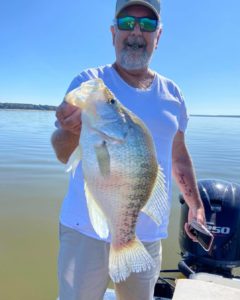Should New Technologies Prompt Changes In Crappie Conservation?

By Greg McCain
Conservation issues involving crappie populations have been a hot-button topic through the first two months this year.
In fact, the debate has raged among fishermen in some states, most notably in Texas, while others are only slowly entering the fray. Regardless of location, the suggestion of imposing more stringent size and creel restrictions on crappie will continue to be fodder for discussion among fisheries personnel and among fishermen and possibly to be the impetus for changes in regulations.
The main consideration in the debate is how much impact advances in technology are having on our crappie populations across the country. That’s probably a soft way of asking this blunt question: Are LiveScope and similar “live” electronics killing our crappie fisheries? Perhaps that idea is an overstatement, but it is certainly being asked.
“Ironically, I just had a discussion with one of our staff members about this very thing,” said Alabama fisheries biologist Damon Abernethy via an e-mail response. Damon is Assistant Chief of Fisheries, Alabama Wildlife and Freshwater Fisheries. “Advances in electronic technology, particularly GPS maps and LiveScope, probably do result in higher catch-rates overall. GPS maps are common, affordable, and come standard on most fishing boats now. This has allowed even novice anglers to locate offshore structure that often holds large schools of fish that only the aces could find 15 or 20 years ago.
“Live Scope is an amazing piece of technology, but it really isn’t affordable for most anglers right now. Only a small percentage of anglers have this type of technology; however, I suspect that will change quickly just like when the GPS maps were new.
“I don’t think we can say with any certainty that the use of this sort of technology has had any population level impacts on the fisheries. Common sense inclines you to think that it would, but we really haven’t seen that in any of our surveys.”
For years, crappie have been one of our most sustainable fishing resources. Among the most prolific breeders in freshwater, crappie generally take care of themselves with very little need for stocking or for overly strict regulations.
Alabama, for example, has excellent crappie fisheries from the Tennessee River in the north to Lake Eufaula (shared with Georgia, where it’s officially called Walter F. George Reservoir) in the southeastern part of the state. Alabama creel limits (30 fish per day per individual) and size limits (nine inches on most waters) are among the most liberal in the country.
Texas has a daily limit of 25 10” crappie with other restrictions imposed at certain times of the year on a couple of major fisheries. Some fishermen, particularly guides whose livelihood depends on sustaining the fishery, fervently suggest that the 25-fish limit is excessive and that the fisheries cannot sustain the pressure. The debate came to a peak in January when several well-known guides went public with the idea that they would restrict catches on their guided trips, self-imposing boat limits below the official regulations established by the state.
The fervor centered around east Texas reservoir Lake O’ the Pines (LOP) where a state regulation demands that fishermen keep the first 25 crappie they catch regardless of size from December through February on select reservoirs. The “keep-the-first-25-caught” rule applies not only to LOP but also to Lake Fork, both prime winter destinations. The premise is based on the idea that winter fish are caught deep on those two fisheries and will not survive if released. If someone catches a five-inch crappie, that fish must legally be included in the creel limit.
This is where LiveScope and other “live” electronic units come into play. In the past, fishermen really didn’t know what size fish they would catch. Now, they can pinpoint the bigger fish with electronics and ignore those that appear to be smaller. At times, the result is a limit of two-lb. fish.

Guide and ACC Crappie Stix pro staff member Les Milligan is one of the fishermen concerned with the rate of big crappie harvested from his home lake.
“LOP has definitely seen an overly-pressured, overcrowded situation,” he said. “The laws are totally outdated. They force you to keep all of the fish in the wintertime.
“LOP is the only place that I can speak to. All the timber in the lake is broken off well below the wintertime lake level. It’s always been known on LOP to go down by the dam and catch a bunch of crappie. There will be 300 or 400 boats down there in the wintertime.
“That was all great before LiveScope because those big huge breeder fish live on those trees, and you couldn’t see the trees to catch them. Those breeder fish would support all the pressure down by the dam, but you couldn’t catch them. Now with LiveScope, you can catch them and they have been taken out of the lake. It doesn’t have the same ability to support itself as in the past.
“Yes, I definitely think there needs to be some laws passed reducing the amount of fish a person can keep because 25 is a lot of fish. I wouldn’t mind seeing them going to something like Mississippi regulations, where it’s something like 15 fish over 12 inches (on some fisheries).”
That last idea actually supports some of the management philosophy already in place in Texas. Speaking on a Facebook Live discussion with ACC pro staff member and Asleep at the Reel YouTuber Chris “Sarge” Gill, one Texas fisheries biologist addressed the issue. Jake Norman, who supervises 13 counties in east Texas (including Lake Fork but not LOP), stated that normally crappie populations are sustained by fish 10 to 13 inches, those in the one-to-three year-old classes.
While larger fish certainly deposit more eggs, the sheer volume in numbers of smaller breeder fish is far greater than the number of two-lb. females, the biologist said, and in turn become the key segment in sustaining the population.
Fishermen, however, don’t always agree with the science proposed by fisheries personnel. The debate definitely has two sides, even among the fishermen. Some are content with current regulations in Texas and in other states. Still, Les – and numerous other guides and other concerned fishermen in Texas – would like to see amendments to the state regulations.
“Something has to change,” Les said. “The lake is getting murdered.
“I only take out up to two clients, and I’m trying to limit them to 30 fish. And anything over two lbs. we are throwing back regardless of what the law says. If they want to give me a ticket for letting go a big fish, please, come on because it’s only going to bring more attention to the need for conservation.”
One of points Texas officials make about keeping current regulations is that bigger fish are nearing the end of their natural life expectancy. In Texas, lifespan is normally up to about five years. They maintain that most bigger crappie die of natural causes by year five.
Damon, the Alabama biologist, generally agrees with that assessment, although he is specifically addressing fisheries in his state.
“Crappie grow fast, but they also die fast,” he said. “For example, going from a nine” (minimum legal length) MLL to a 12” MLL for crappie on Jones Bluff (on the Alabama River) would increase the number of 12” fish by about 10%, but it would also result in more than a 50% reduction in the number of harvestable-sized fish. This is because natural mortality is very high. Protecting crappie through 12” is only beneficial if they live long enough to attain that size. In Jones Bluff, almost 5X more crappie die from natural causes than from angler harvest.
“Anglers self-imposing a lower bag limit is noble but will not improve a fishery where harvest is not the limiting factor. There’s really no legitimate management reason for them to do this. If a fishery will benefit from a lower bag limit, then WFF will lower the bag limit. I think many anglers are often misled by their peers into thinking that catch-and-release makes all fisheries better. This simply isn’t true.
“If they like to eat fish (and who doesn’t like crappie), then they should feel free to take them home and eat them. Just follow the state regulations, and their lakes will be fine. We monitor all of them on a regular basis and will make changes where changes are needed.”
Not all crappie populations are created equally. Differing life expectancies create a different set of standards from region to region. Managing fish populations for different purposes also figures into play at times.
YouTuber (Flopping Crappie) and ACC pro staffer Davis Lenzen makes good points about that potential part of the conservation equation.
“There always seems to be an ongoing discussion about size and creel limits,” Davis said. “Up north, the conversation usually is around walleye, but in recent years bluegill and crappie regulations have become more scrutinized. The question that always needs to be asked before going into what size limits or bag limits should be is “what are we managing for?”
“Are we managing for trophy potential or for quantity? Most lakes in my area are managed for quantity when it comes to panfish, the reason being people still view panfish as a meal and not a trophy.”
Creel limits are treated somewhat differently on Davis’ home lakes in Wisconsin than in other parts of the country. Aggregate limits of panfish (bluegills, crappie, and others) range from 10 to 25 on different fisheries while others have separate limits on crappie.
Regardless of the state or region of the country, change appears to be coming. Catch-and-release was once considered a novel concept but is now the norm among bass fishermen and for other species, notably trophy catfish. Fishermen can help dictate change, especially those who hold a prominent place in the fishing culture.
Along those lines, a group of guides who work the Big Four lakes in central Mississippi are in the tentative stages of implementing their own standards. While Mississippi fisheries personnel have been proactive in their management of Corp of Engineer reservoirs, according to Tim Howell, of Long Branch Guide Service and another ACC Crappie Stix pro staff member, he said self-imposed changes are coming.
Currently, fishermen are restricted to 15 crappie per day (40 per boat regardless of the number of anglers) with a length restriction of 12” on Grenada and the other Corp of Engineer reservoirs along the I-55 corridor. The guides met and developed a list of potential changes, among them instituting a 30-fish boat limit per day, “encouraging” the release of trophy fish, and posting fewer “tailgates-loaded-down-with-big-crappie” pictures to social media.
“Of course, we’re not going to lose clients over it,” Tim said, “but we will be doing some of these things. If a client is not going to mount a three-lb. crappie, what’s the need to keep it? There’s plenty of other fish to eat.
“We’ve seen what LiveScope can do. We want to stay ahead of this. We don’t want to get a couple of years down the road and realize there’s a major problem.”

The issue probably goes beyond self-policing by the fishing community, however. State agencies likely will have to make official changes before all parties are on board. That doesn’t appear to be on the agenda, at least not in the immediate future.
The tentative nature of change is one thing perplexing to fishermen.
“I just think government agencies are slow to move and don’t really care how many big crappie are in a body of water,” said ACC Crappie Stix owner Andy Lehman. “Also, they don’t spend every day on the water catching these fish. No one knows more about a body of water than the locals and the guides. They can show you what they caught 10-15 years ago (without LiveScope) and what they are catching now.
“I’m glad guides are getting together and taking some proactive measures.”
In the late 1960s, many looked at B.A.S.S. founder Ray Scott with a skeptical attitude. He wanted anglers to compete in bass tournament, and even more revolutionary, he wanted them to release their catch after weighing them. From those novel concepts, Ray Scott is hailed as an iconic figure, a ground-breaking pioneer in the fishing world. Right or wrong, fishermen are now shamed on social media for putting a knife to a bass.
Will the same attitude take root among crappie fishermen? The future is now in crappie fishing, courtesy of LiveScope. The eye-opening technology has done more than becoming a deadly tool in the hands of fishermen. It has prompted a discussion that will likely lead to changes in crappie conservation, official or not. From that perspective, LiveScope and other “live” electronics are wondrous things.













